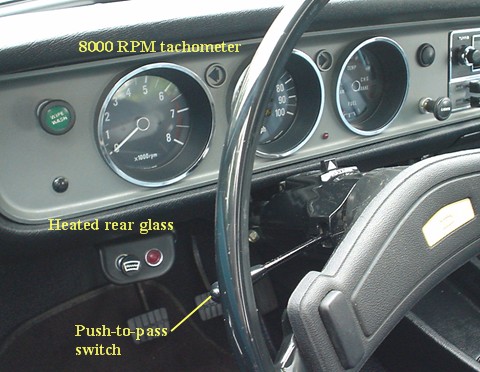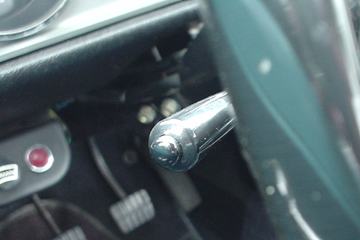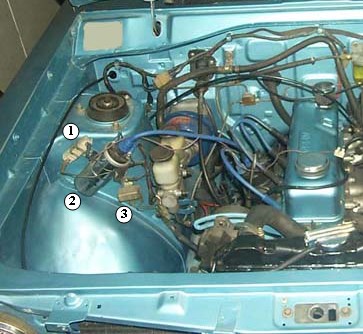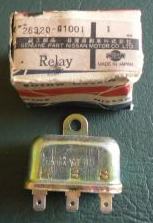| Revision as of 05:58, 9 January 2013 ddgonzal (Talk | contribs) <- Previous diff |
Revision as of 21:00, 25 November 2017 ddgonzal (Talk | contribs) Next diff -> |
||
| Line 1: | Line 1: | ||
| - | A passing light feature was an option for B110. If your turn-signal lever has a push-button on the end, it's the passing light switch. Push it in, and the headlights light while it's pushed in (regardless of whether lights are on or off). | + | A passing light feature was an option for B110. If your [[Turn Signals|turn-signal]] lever has a push-button on the end, it's the passing light switch. Push it in, and the headlights activate while it's pushed in (regardless of whether lights are on or off). |
| = Passing Light Switch = | = Passing Light Switch = | ||
| This is composed of two parts: | This is composed of two parts: | ||
| * The switch itself is part of the turn signal (on the steering column). | * The switch itself is part of the turn signal (on the steering column). | ||
| - | *: [http://datsun1200.com/modules/myalbum/photo.php?lid=14968 http://datsun1200.com/uploads/thumbs/14968.jpg] [http://datsun1200.com/modules/myalbum/photo.php?lid=14971 http://datsun1200.com/uploads/thumbs/14971.jpg] | + | *: {{Album|14968}} {{Album|14971}} |
| * The relay. 1200s don't use headlight relays, except for this optional Passing Switch. It looks very much like the Horn Relay. | * The relay. 1200s don't use headlight relays, except for this optional Passing Switch. It looks very much like the Horn Relay. | ||
| ** 25230-89912 RELAY-passing lamp (4-connector relay on early models) | ** 25230-89912 RELAY-passing lamp (4-connector relay on early models) | ||
| ** 25230-89905 RELAY-passing lamp (3-connector relay from 1971 Apr) | ** 25230-89905 RELAY-passing lamp (3-connector relay from 1971 Apr) | ||
| ** 26320-14800 RELAY-horn (has 3 connectors, located by Coil) | ** 26320-14800 RELAY-horn (has 3 connectors, located by Coil) | ||
| - | **: [http://datsun1200.com/modules/myalbum/photo.php?lid=14969 http://datsun1200.com/uploads/thumbs/14969.jpg] [http://datsun1200.com/modules/myalbum/photo.php?lid=14970 http://datsun1200.com/uploads/thumbs/14970.jpg] | + | *: {{Album|14969}} {{Album|14970}} |
| = Wiring = | = Wiring = | ||
| - | Note that this just wires in series with the standard wiring. From the 'L' fuse to the high-beam wiring, the switch bypasses simply the regular switch, firing the Main Beams. | + | Note that this Passing Lamp just wires in series with the standard wiring. From the 'L' fuse to the high-beam wiring, the switch bypasses simply the regular switch, firing the Main Beams. |
| - | [http://datsun1200.com/modules/myalbum/photo.php?lid=5027 http://datsun1200.com/uploads/thumbs/5027.jpg] | + | Passing Light Switch circuit. The red circle indicates the part of the T/S switch that is different from a normal T/S switch |
| - | <br>Passing Light Switch circuit | + | <br>{{Album|5027}} |
| - | * The red circle indicates the part of the T/S switch that is different from a normal T/S switch | + | |
| - | [[Category:Body Electrical System]] | + | [[Category:Body Electrical System]]{{End}} |
Revision as of 21:00, 25 November 2017
A passing light feature was an option for B110. If your turn-signal lever has a push-button on the end, it's the passing light switch. Push it in, and the headlights activate while it's pushed in (regardless of whether lights are on or off).
Passing Light Switch
This is composed of two parts:
- The switch itself is part of the turn signal (on the steering column).
- The relay. 1200s don't use headlight relays, except for this optional Passing Switch. It looks very much like the Horn Relay.
- 25230-89912 RELAY-passing lamp (4-connector relay on early models)
- 25230-89905 RELAY-passing lamp (3-connector relay from 1971 Apr)
- 26320-14800 RELAY-horn (has 3 connectors, located by Coil)
Wiring
Note that this Passing Lamp just wires in series with the standard wiring. From the 'L' fuse to the high-beam wiring, the switch bypasses simply the regular switch, firing the Main Beams.
Passing Light Switch circuit. The red circle indicates the part of the T/S switch that is different from a normal T/S switch
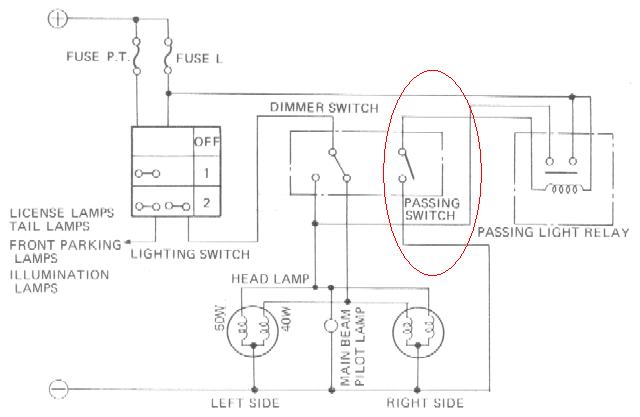
¤

![[Datsun 1200 encyclopedia]](/wiki/upload/wiki.png)
